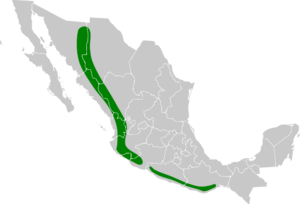Eared poorwill facts for kids
Quick facts for kids Eared poorwill |
|
|---|---|
| Conservation status | |
| Scientific classification | |
| Genus: |
Nyctiphrynus
|
| Species: |
mcleodii
|
 |
|
The eared poorwill (scientific name: Nyctiphrynus mcleodii) is a special type of bird. It belongs to a group of birds called nightjars. These birds are known for being active at night. The eared poorwill lives only in Mexico. This means it is an endemic species to that country.
Contents
About the Eared Poorwill
The eared poorwill is a fascinating bird. It is part of the Caprimulgidae family. This family includes other nightjars. The eared poorwill gets its name from small feathers on its head. These feathers look a bit like ears.
What Does the Eared Poorwill Look Like?
The eared poorwill is about 20 to 21 centimeters (8 inches) long. That's about the length of a standard pencil. Male birds usually weigh between 30.8 and 37 grams. Females are a bit lighter, weighing 24 to 35.3 grams.
Most eared poorwills have grayish feathers. They have black and white spots on their wings. A white band goes around their neck. This band is wider on their throat. The special "ear tufts" are feathers on their crown. These feathers stick up. Their chest is grayish, and their belly is a light brown color. The tail feathers have white tips. Only the very middle tail feathers do not have white tips.
Some eared poorwills have a different look. They are called a "rufous morph." These birds are cinnamon to reddish-brown all over.
Where Does the Eared Poorwill Live?
The eared poorwill lives mostly in western Mexico. You can find them from the states of Chihuahua and Sonora in the north. They live south to Jalisco and Colima. Some are also found in Guerrero and Oaxaca. Birds in Oaxaca seem to move around. They are only seen there between February and May.
These birds like to live in open forests. They prefer pine and oak or just oak woodlands. These areas are often semi-arid and mountainous. You might also find them in wooded valleys. They live on hillsides below cloudforests. Sometimes, they are seen in overgrown fields. They usually live at heights from 600 to 2000 meters (about 2,000 to 6,500 feet). But they have been seen as high as 2500 meters (about 8,200 feet).
Eared Poorwill Behavior
How the Eared Poorwill Finds Food
The eared poorwill hunts for insects. It flies out from trees or the ground to catch them. This is called "sallying." Its favorite foods seem to be beetles and moths.
Eared Poorwill Reproduction
Eared poorwills seem to lay their eggs between April and June. They do not build a nest. Instead, they lay two eggs directly on the ground. Both the male and female birds take turns sitting on the eggs. This helps keep the eggs warm until they hatch.
What Sounds Does the Eared Poorwill Make?
The male eared poorwill has a special song. It is a loud, sudden "peeyo" or "peejo." The sound ends very strongly. The male sings this song at night. He can sing from a tree branch or from the ground. The bird also makes a sound that goes down in pitch. It sounds like a wavering "teu-uu-uu." Other calls include "gwik," "wuik," and "chuck" sounds.
Eared Poorwill Conservation Status
The IUCN (International Union for Conservation of Nature) checks on animals. They first thought the eared poorwill was "Near Threatened." This means it might be at risk. But since 2004, they have changed its status. Now, it is listed as "Least Concern." This is good news! It means the bird is not in immediate danger.
The eared poorwill lives in a large area. It also has a big population. However, the number of birds is thought to be going down. Still, no big threats have been found right now.


